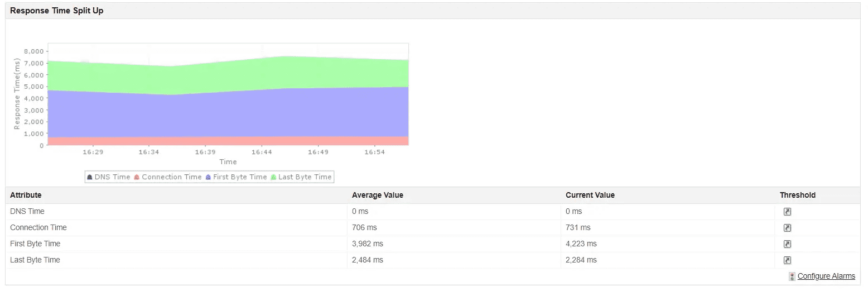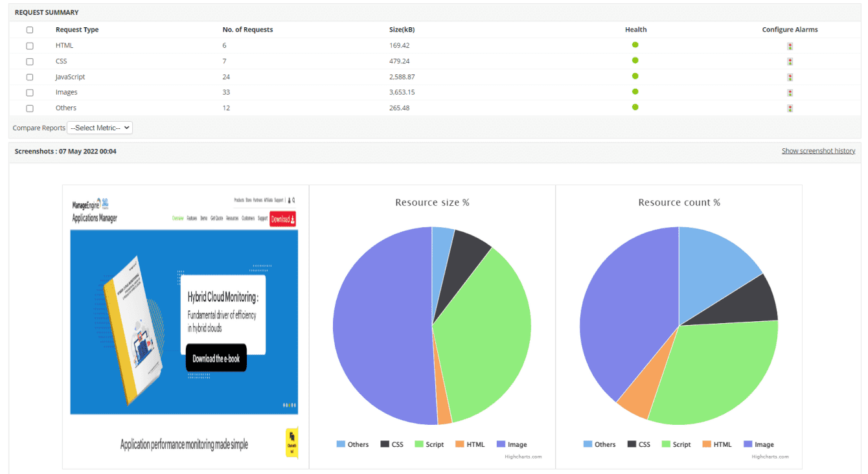3 essential website monitoring metrics to improve how your website functions
Most businesses utilize a web platform to promote their products or services in the digital age. A website with good response time and availability can boost the credibility of your business. However, websites are susceptible to lag and downtime, both of which result in frustrated end users. Following a poor user experience, potential customers may opt for other organizations that provide similar services. Without a functional website, potential customers may question the legitimacy of an enterprise.
There is a direct correlation between the performance of a website and its brand image. Websites play a major role in alluring potential customers and have become a vital part of business. A well-performing website delivers a seamless end-user experience without making users wait for webpage elements to load.
This is why website performance monitoring is crucial to dodge performance hiccups and help establish the efficacy of an enterprise. It provides information on your website’s important metrics and web transactions, giving you insight into its availability, so you can focus on increasing sales conversion rates, launching creative market campaigns, and other important tasks.
What is website monitoring?
Website monitoring requires testing and validating that your website is operating for end users as anticipated. You need to keep track of your website’s availability and performance at all times to avoid performance setbacks.
Importance of website monitoring
Let’s explore in more detail how website monitoring can markedly influence both your online presence and the overall user experience:
- Support seamless transactions: Any hiccup during website transactions will inconvenience and dissatisfy your end users. When lapses occur at a critical moment, such as when an end user is just a click away from completing a purchase, end users may lose the patience to remain until the issue is resolved. So it’s critical for businesses to not only work towards improving their products and offerings but their website and its functionality as well.
- Become aware of problems before your customers: Websites can experience downtime due to various reasons, such as high traffic, coding malfunction, or server failure. This is where website monitoring comes into play by tracking the performance of the website and its critical components 24/7. It sends you alerts as soon as it discovers a degradation in performance, which helps you reduce your mean time to identify (MTTI) and mean time to repair (MTTR).
- Boost your online presence: The health and performance of a website are closely linked to its search result ranking. Even 15-minutes of downtime can have an impact on a website’s SEO rankings. If a website is non-functional for an entire day, its search result ranking can drop by an average of 30% within six hours. This can lead to the website being removed from the Google Index altogether.
- Establish brand credibility: A brand’s online reputation plays a vital role in determining its growth and how it’s perceived. So, it’s imperative for businesses to establish and maintain a positive reputation. Brand reputation monitoring can prevent your website from getting blacklisted, notify you if your website gets marked as unsafe, and identify any suspected malware and phishing attempts.
- Monitor the latest website configuration changes: Website monitoring can help you gain a good picture of how your website works under various circumstances, especially when there is a lot of traffic. By analyzing historical and statistical data, you can make informed decisions to build a high functioning and competent website. This includes evaluating the impact of new plug-ins and integrations to ensure they enhance rather than impede your website’s performance.
Three essential metrics you can track using website monitoring
1. Website availability

Based on Gartner’s research, while the cost of downtime will vary based on the size and type of the organization, 33% of organizations reported that a one-hour downtime cost $1-5 million.
| Uptime percentage in a year | Downtime in minutes | Approximate cost of downtime |
| 99.99% | 525.6 | $4,730,400 |
| 99% | 5,256 | $47,304,000 |
| 98% | 10,512 | $94,608,000 |
Website uptime is critical to a business. Excessive downtime can erode your site’s reputation amongst existing customers and give new visitors a poor impression. Although website downtime is unavoidable, using website monitoring tools, you can get alerted the moment your website goes down and take the required remedial action, helping you reduce downtime. You can also track website availability based on the end user’s location.
2. Response time

End users today expect fast, responsive websites, with an anticipated response time of approximately 0.1 seconds. According to BigCommerce, “a one-second delay in page load time has been shown to cause a 7 percent loss in conversion and 11 percent fewer page views.”
Page load time or response time is the time taken by the webserver to establish a connection and transmit data packets to the end user’s browser. In simpler words, it is the time taken for a page to appear on your screen.
The website response time is compounded as the sum of the DNS query time, SSL handshake time, connection time, and the time it takes to download all the web server’s HTML content. A professional website monitoring tool provides you with real-time insights into response times of these various website components, enabling you to address issues rapidly.
3. Website content changes

Hackers may target your website and alter its content without your knowledge. This can be damaging to your company’s reputation, especially if your end users notice it before you do. Not to mention you risk losing sensitive data to hackers, which can be used to threaten or destroy your business.
When an unauthorized individual modifies the content or look of a webpage, it is referred to as website defacement. Hackers modify the code and scripts of a website using methods such as code injection, pharming, cross-site scripting, phishing, and remote code execution. Inspect your website frequently to ensure that it has not been tampered with by unauthorized individuals.

Using a website monitoring tool, you can receive alerts the moment there’s a change in the website content. You can also track unplanned code changes as well as broken or missing elements of the webpage.
Why is Applications Manager the ideal choice?
Applications Manager is a software that offers in-depth insights into the health and performance of your applications, servers, databases, and websites hosted on various frameworks. Applications Manager provides features such as real user monitoring (RUM) and synthetic monitoring to make the end user’s digital experience seamless. It also promptly alerts you when issues arise on your website by making use of Applications Manager’s website monitoring and website content monitoring capabilities.
You can effectively monitor your website’s availability using Applications Manager’s webpage analyzer or by creating a URL monitor to quickly receive alerts anytime your website is unavailable. This enables you to resolve website downtime, slow loading times, and network latency before it affects your business. It also analyzes your website’s response time and split-ups.
With the URL sequence monitoring feature, you can monitor multiple webpages and the sequence in which the webpages are invoked. You can also monitor website content and various metrics such as details on vandalized content and the percentage of defacement.
The synthetic transaction monitor simulates and records possible user journeys though your web applications. It launches browsers from across various geographical locations and monitors data harvested from the simulated transactions. It tracks how multiple components of a web application load along with how the end users view and perceive them.
Applications Manager, a part of ManageEngine’s ITOM suite of solutions, supports over 150 applications out of the box. It is the one-stop-solution to all your application and website monitoring needs, offering AI-powered alerts and reports. Download a free, 30-day trial and start monitoring your websites and applications now!